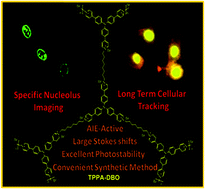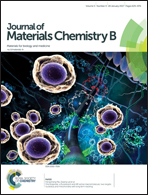One bioprobe: a fluorescent and AIE-active macromolecule; two targets: nucleolus and mitochondria with long term tracking†
Abstract
Specific organelle imaging and long-term cellular tracking are of paramount importance in monitoring biological processes, pathological pathways, and therapeutic effects, etc. Herein, we report a novel macromolecule fluorescent probe (TPPA–DBO), which is synthesized from tris(4-(pyridin-4-yl)phenyl)amine (TPPA) and 1,8-dibromononane (DBO) with a gram scale by a simple method. TPPA–DBO demonstrates a highly specific nucleolus-targeting ability, which is very challenging in the bioimaging research field. We have shown that the green nucleolus-specificity probe TPPA–DBO has advantages over the commercially available nucleolus-staining probes such as DAPI, Hoechst dyes and SYTOs in terms of its AIE-performance, large Stokes shift (175 nm), excellent photostability, and promising usefulness in live cell imaging experiments. Surprisingly, after internalizing TPPA–DBO into the nucleus region for a period of time, some TPPA–DBO are reversely diffused from nucleolus into the cytoplasm, thus resulting in the staining of mitochondria with a redder emission color. This research result may provide a new concept of cellular tracker design and provide insight into biological questions, understanding disease mechanismss, and designing new therapeutic strategies.


 Please wait while we load your content...
Please wait while we load your content...